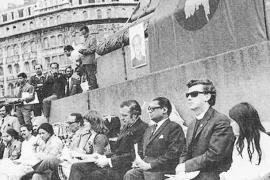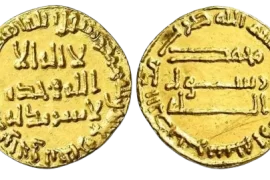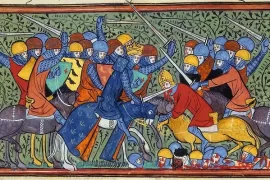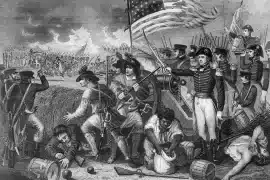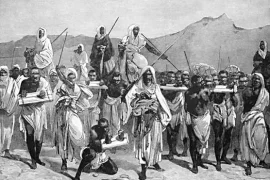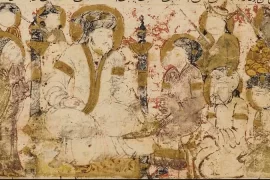The Achaemenid Empire was a vast and powerful empire that ruled over much of the Near East and Central Asia from 550 BCE to 330 BCE. Founded by Cyrus the Great, the Achaemenids established an extensive network of roads, built impressive architectural marvels such as the Persepolis, and developed a complex administrative system that allowed for a degree of cultural and linguistic diversity among its subjects. The empire was also known for its tolerance towards different religions and cultures, allowing its subjects to practice their own beliefs and customs. Despite facing challenges such as succession crises and regicide, the empire remained remarkably cohesive, displaying no signs of internal stagnation or weakness until its eventual downfall under Alexander of Macedon’s conquest, which deposed the last Achaemenid king, Darius III.
Foundation of the Achaemenid Empire
Cyrus II “the Great”, reigned from 559 to 530 BCE, was the ruler of the small kingdom of Anshan, located in the southwestern region of Iran’s Zagros Mountains. Anshan was once culturally influenced by the Elamites, a sophisticated and powerful civilization, and the earliest Persian monarchs saw themselves as natural inheritors of Elamite lands and possibly even as custodians of their culture.
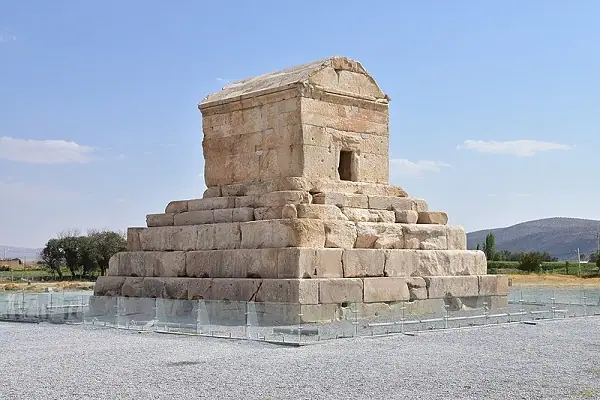
At the beginning of his reign, the Persians were vassals to the Medes, a powerful tribal kingdom in northern Iran. In 550/549 BCE, Cyrus led a coalition of south Iranian groups in a war against the Median king, Astyages. After sacking Ecbatana, he shifted his focus towards northern Media, including the ancient kingdom of Urartu near Lake Van. There are indications that Cyrus also occupied Elam and waged a campaign in Bactria. He then turned towards Lydia, a wealthy and powerful kingdom in Asia Minor, which he conquered in 546 BCE after sacking Sardis. He took other important cities along the Ionian coast, which were then placed under Persian satraps.
By 540 BCE, Cyrus was ready to attack Babylon and marched his army into Mesopotamia. He entered Babylon on October 29, 539 BCE, and took its king, Nabonidus, prisoner. Cyrus appointed his son, Cambyses, as the city’s regent and allowed Babylonian officials to continue their governance and religious practices. The fall of Babylon is primarily known through the Cyrus Cylinder, a clay deposit found near the sanctuary of the god Marduk. Written from a Babylonian perspective, the Cylinder legitimized Cyrus’ conquest of Babylon by portraying him as Marduk’s champion, who saved Babylon from tyranny. It also highlighted the benefits of Cyrus’ rule for the Babylonians. However, not all peoples fared well under Cyrus, as the citizens of Opis were massacred, and after the fall of Lydia, the population was deported to Nippur.
In the years following the conquest of Babylonia (538–530 BCE), Cyrus expanded his empire to include Aria, Parthia, Sogdiana, and Margiana on the eastern front, and Cilicia, Syria, and Palestine in the west. His conquests established the Achaemenid Empire as one of the world’s greatest empires, with Cyrus as its founder and first ruler.
Cyrus built a tomb and palace in Pasargadae, located in southwest Iran, where he also created a beautiful formal garden with an intricate network of water channels. This oasis was known as pairidaêza (Greek paradeisos), and it symbolized a miniature version of the empire, showcasing plant life from all the territories that Cyrus had conquered, serving as a physical representation of Persia’s expanding imperial might.
Expanding the Empire
Cyrus passed away in battle against the Massagetae in 530 BCE, and was succeeded by his son Cambyses (r.530-522 BCE). Cambyses appointed his younger brother, Bardiya, as the governor of Media. His most notable accomplishment was the conquest of Egypt, Libya, and Cyrene. Although Greek sources depicted Cambyses as a tyrant, much of this negative portrayal can be attributed to Egyptian priests who opposed his attempts to curtail their power. In reality, Cambyses practiced religious tolerance and worked to maintain his sovereignty by enlisting the support of Egyptian nobles while respecting their religious and cultural traditions, much like Cyrus did in Babylon.
Cambyses died in Egypt during the summer of 522 BCE, and after a brief rule, Bardiya was assassinated. This led to a violent and bloody palace coup, which resulted in Darius I (r.522-486 BCE), the governor of Parthia, taking the throne. Rebellions erupted across the empire, and chaos spread from province to province, including Babylon, Media, Armenia, and Scythia, as they attempted to break free of Persian rule. Darius swiftly and ruthlessly suppressed the revolts, bringing the empire back under control in little more than a year, an impressive feat.
After successfully quelling the rebellions and executing their leaders, Darius I maintained a firm grip on the empire and expanded its borders into the Punjab in 518 BCE and attempted to conquer the Scythians in 513 BCE. Under his reign, the empire extended from Libya to Bactria and Darius was dedicated to empire-wide building and engineering projects, such as the construction of a canal between the Nile and the Red Sea and the expansion and embellishment of Ecbatana and Pasargadae, as well as a massive building program at Persepolis. The administrative capital was established at the Elamite city of Susa, where Darius recruited workmen from across the empire to build and decorate his palace. Although he had aspirations to incorporate Greece into the empire, he died before launching a campaign, leaving the task to his son Xerxes, who ruled from 485-465 BCE. Xerxes continued his father’s policies, but our knowledge of his reign is limited mainly to the western periphery, as we rely mostly on Greek sources, and evidence for the later years of his reign is scarce and speculative.
Xerxes, upon assuming the throne, had to quell a rebellion in Egypt that had already started during his father’s reign. In 481 BCE, Babylonia revolted and Xerxes divided the large satrapy into two smaller ones: “Babylonia,” consisting of modern-day Iraq and Syria, and “Beyond the River,” consisting of Syria-Palestine and lands west of the Euphrates. Xerxes’ attempt to assert Persian dominance over mainland Greece failed, despite his capture of Athens in 480 BCE, as his navy was defeated at Salamis and his army at Plataea in the following year. The Greeks’ victories at these battles marked a turning point in their relationship with Persia, as it became apparent that the Persian army was not invincible. The Greek cities in Asia Minor gradually gained more independence, and Persia lost territory in Europe over the following decades. Xerxes was assassinated in a palace coup in August 465 BCE, and after his reign, the Achaemenid Empire did not expand further, though nationalist or localized revolts continued to occur.
Mature Achaemenid Empire
Following the death of Xerxes, the Persian Empire underwent a period of renewed military activity and territorial expansion during the later Achaemenid period, rather than stagnation. Artaxerxes I (r.465–425 BCE) was succeeded by his sons, with the youngest, Darius II (r.423–405 BCE), eventually passing the throne to his eldest son Artaxerxes II (r.405–359 BCE) without issue. However, Artaxerxes’ younger brother, Cyrus the satrap of Lydia and Phrygia Minor, attempted to seize the crown and gathered an army from his satrapy and Greek mercenaries, but was ultimately killed in battle against Artaxerxes’ troops at Cunaxa in Babylonia in 401 BCE. During this time, Egypt successfully broke free of Persian control, leading to continuous efforts by the Persians to regain control over the province for the next 56 years. The Persians also focused on maintaining control over Syria-Palestine and Asia Minor, and in 387/386 BCE, Artaxerxes imposed a settlement on the Greeks, known as the “King’s Peace,” which recognized Persian control over the cities of Asia Minor. Artaxerxes II was succeeded by his son Artaxerxes III (r.359–338 BCE), who reconquered Egypt after hard and brutal campaigning and crushed a revolt in Phoenicia. Artaxerxes IV’s reign was short-lived, and he was replaced by Darius III (r.336–330 BCE) from a collateral branch of the Achaemenid family. Darius posed a serious threat to Alexander of Macedon’s dreams of glory and met him in battle at Issus in 333 BCE and again at Gaugamela in 331, but was defeated at both encounters. Darius fled north to raise more troops and was ultimately killed by his satrap, Bessus, in 330 BCE.
Pax Persiaca
The monarchs of the Persian Empire believed that kingship was a gift from the god Ahuramazda, and they frequently claimed to be champions of Truth (arta) who crushed rebellions to restore order, which was seen as necessary for cosmic harmony. Any revolt against Persian rule was therefore viewed as a challenge to divine authority.
To manage the empire’s tribute collection, Darius I created administrative satrapies, which were geographic regions responsible for paying tribute to the Persian throne. Darius’ Bisitun Inscription provides the oldest known list of the empire’s provinces, which begins with Persia and Elam as the core lands. The order of the provinces in the inscription follows a roughly clockwise pattern, beginning with the western provinces or satrapies, followed by those in the north and then the east. Interestingly, the ordering privileges lands closer to the imperial center over those at the periphery of the empire, suggesting an Achaemenid ideology of hierarchy in which proximity to Persia was considered a marker of higher civilization.
In the Bisitun Inscription, Darius I employs a comprehensive range of titles available to any Persian king, including “Great King,” “King of Kings,” and “King of the Countries,” as well as a less commonly used but still significant title: “King on this (Great) Earth (Even Far Off).” In foreign territories under Achaemenid control, the Great Kings adopted and adapted local titles, as seen with Cyrus II in Babylon and Darius I in Egypt. The administration of the empire was managed by “satraps,” who were exclusively selected from the highest levels of the Persian aristocracy. These satraps acted as representatives of the Great King and were responsible for collecting taxes and tribute, raising armies, and making governmental decisions at a regional level. However, for issues of international importance, satraps were required to consult with the king and his top advisors. As representatives of the king, satraps maintained court locally and upheld court ceremony based on that at the heart of the empire.
Each satrapy in the Achaemenid Empire covered a vast area and was governed from a capital city, which served as the administrative hub for the satrap. These regional centers were also used as storage for taxes, paid in coins and goods, including foodstuffs for the satrap’s court and its subjects. However, valuable metals and goods were also commonly collected as tax payments. The palaces in these capitals were vital for provincial administration and were the locations where royal orders were delivered to the satrap from the central authority. These orders, identified by the king’s seal, were found in places as far as Nippur, Samaria, and Artašat in Armenia, with the largest collection of royal seals discovered in Daskyleion, Anatolia. Archives were kept of all royal and satrapal decrees for future reference.
To maintain a functioning system, the satraps relied on cooperation from local elites, and often utilized established regional administrative systems. The success of the empire was also due in part to its superior infrastructure, with well-maintained roads connecting the major satrapal centers to the imperial core. The most significant of these roads was the Royal Road, which ran from Sardis to Persepolis via Susa and Babylon.
The extensive territories of the Persian Empire were ruled by satraps, each with their own regional capital and palace, used for both taxation and administration. The Persian kings did not impose their language or culture on conquered nations, instead utilizing local languages for their decrees and employing Aramaic as a form of lingua franca for effective communication. They also made an effort to appear as upholders of local religions to maintain control of sanctuaries and powerful priesthoods. However, rebellious subjects and states were treated ruthlessly, with populations uprooted and holy shrines destroyed. The Persian military consisted of infantry, horse cavalry, camel cavalry, and elite charioteers, with subject and mercenary Greeks also incorporated. The Ten Thousand, or “Immortals,” served as the royal bodyguard. Although the Achaemenid Empire facilitated significant contact between East and West, its founding and maintenance relied on military might and harsh punishments for dissent. It paved the way for the concept of empire and influenced Alexander’s vision of what an empire could be.

